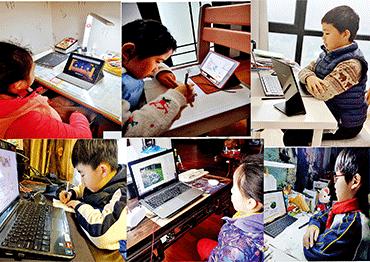Lisa Xu, mother of a second-grader in Beijing, said she chose free courses from New Oriental and TAL to supplement the “Cloud Classroom,” a MoE-supported online learning platform that mainly uses video and PowerPoint slides.
Xu is one of millions of Chinese parents turning to online education for the first time in the wake of the outbreak. But behind these charitable services is a pitched battle for market share.
Youdao, a major education brand under internet giant NetEase, began the wave in January by providing free lesson access to students in Hubei Province, the epicenter of the outbreak. English-language learning platform VIPKid was close behind, opening 1.5 million free online lessons to students ages 4 through 12 (also mainly for Hubei students). Others followed suit, including industry leaders New Oriental and TAL.
Tech giants like Alibaba, Tencent and ByteDance also rushed in by providing access to online teaching technologies, while video platforms iQiyi, TikTok and Kwai (aka Kuaishou) began developing their own education services.
The increased traffic boosted the numbers of registered users. Genshuixue, an online education platform, attracted 15 million new students through free lessons, nine times its paying user base in 2019. Rival Zuoyebang, which focuses on K-12 students, saw 28 million users by mid-February.
“Besides new customers enticed by free courses, enrollment for our one-on-one lessons also hit record highs thanks to soaring demand,” said Li Guoxun, executive dean of the VIPKid Children’s Research Institute, adding that their teachers working remotely in North America have much busier schedules than usual.
Due to the outbreak, the online education industry stands to gain at least 50 million users, said Jiang Kaiyang, vice president of Taihe Capital, an investment management company.
This comes as a windfall to the online education industry, which despite seeing steady growth since 2011 has been plagued by the high costs of courting subscribers.
In 2018, revenue from online education made up less than 10 percent of the education market, which was still dominated by offline education, according to industry analyst iResearch. Many businesses are still burning through cash and relying on financing to develop products. Most are still without viable business models.
“The cost of gaining users is an important reason behind the difficulties online education companies face in turning a profit,” said Xiong Bingqi, vice director of non-profit organization 21st Century Education Research Institute.
Based on a New Oriental report, Xiong concluded that online companies must spend at least 3,000 yuan (US$432) for every new student compared to 500-1,000 yuan (US$72-144) per student for brick-and-mortar operations.
According to its annual financial report released January 27, Youdao suffered 600 million yuan (US$86m) in losses in 2019, a substantial increase compared to 2018 due to rising operating costs. The company spent 623 million yuan (US$89m) on marketing alone, the report read, mainly while competing for students over the summer holidays.
Online tutoring platforms ATL, Yuanfudao and Zuoyebang all spent billions on marketing for returns of around 1 million users each.
The business generated during the outbreak would have otherwise cost hundreds of billions in marketing.
In addition, online education has extended its reach into smaller cities, said Wu Xiaozheng, who has worked at a major online education company for over 10 years. “There is obvious growth in the number of students from third- and fourth-tier cities,” he added.
Insiders expect the surge in use to help raise public awareness of online education. Its market penetration rate was only 10 percent in 2018, much lower than online services such as payment and medical care, according to data from Forward Intelligence, a Chinese market research provider.
“In the past, online education platforms needed to work to cultivate consumers. Now the majority of users, whether from large or small cities, have gotten used to the idea. They’ll find it easier to accept online learning and be more willing to choose it in future,” Li told NewsChina.

 Old Version
Old Version

